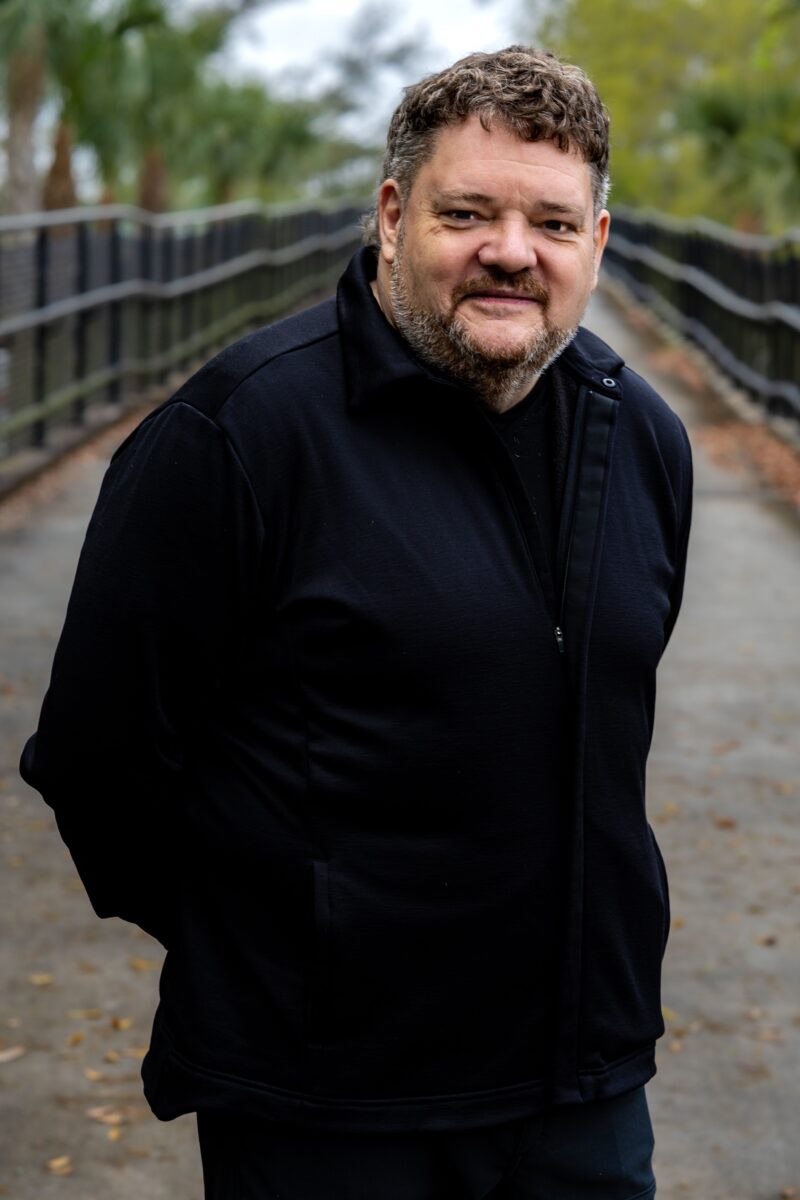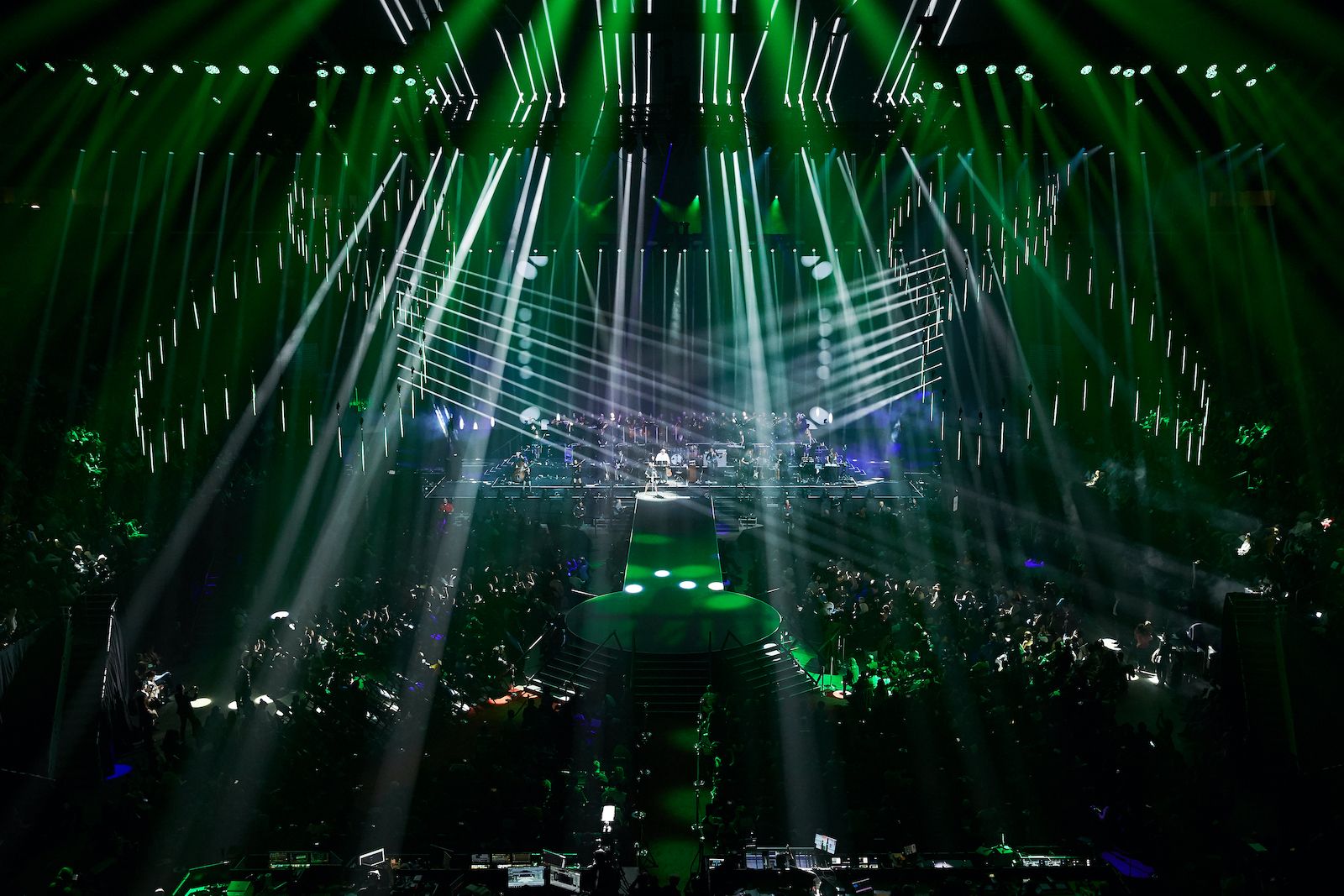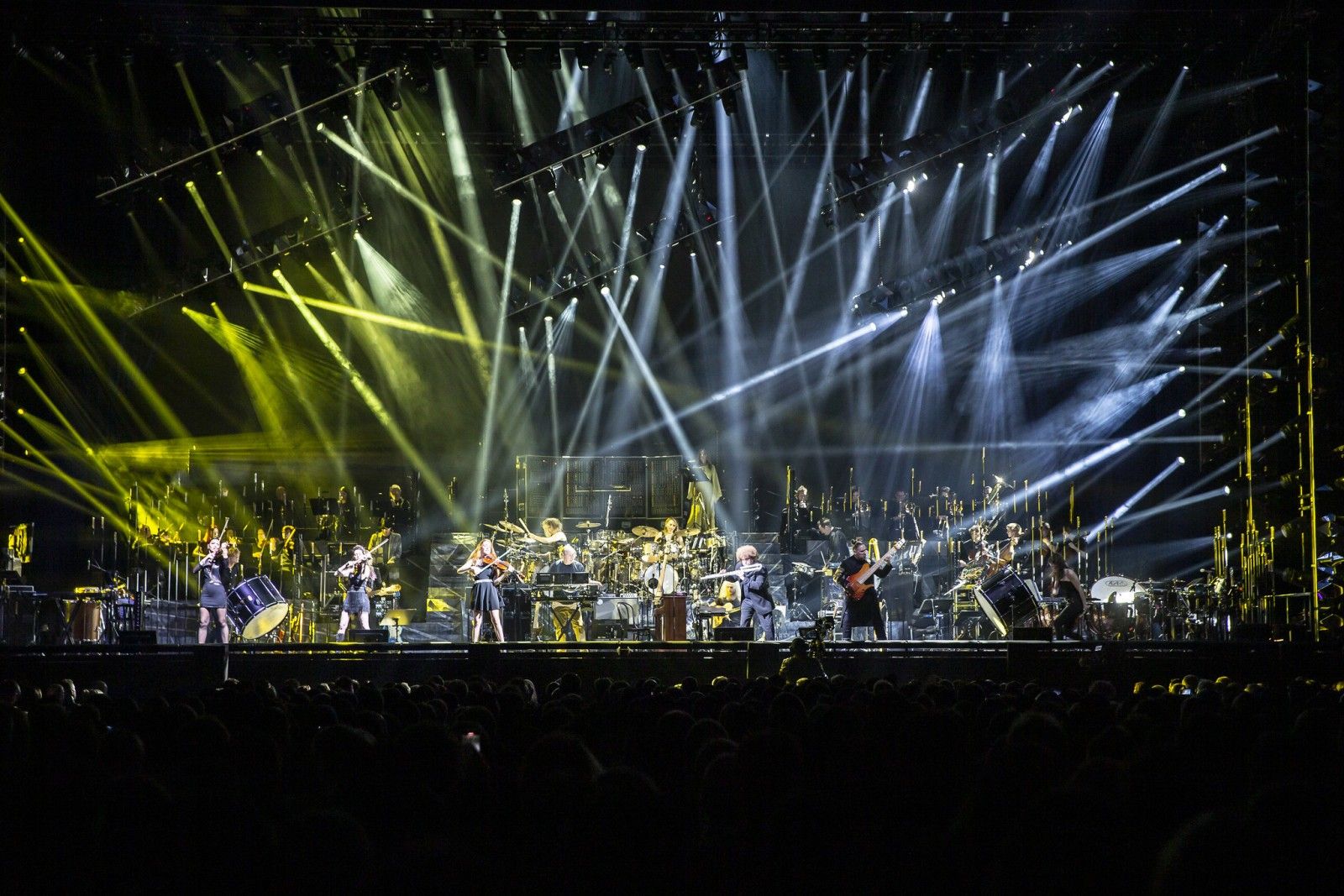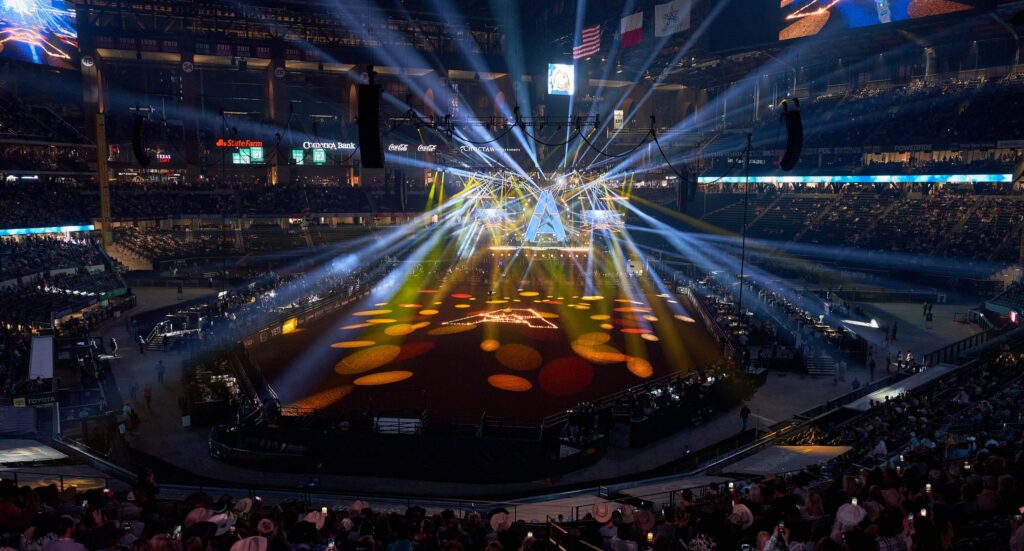John Featherstone Reflective Light
Posted on August 6, 2024
“We are the holders of our client’s vision.” This simple, basic ethos has been at the core of this England-born designer’s career from the very beginning, when he first plied his skills as a teenager, lighting a local rock group called The Smiths. Much has happen since then, both to the band, and to John Featherstone.
 He made a name for himself as a designer, building an impressive body of work lighting the likes of The Cure, Duran Duran, Van Halen, The Pretenders, and many other iconic artists. After moving to the USA, he cofounded Lightswitch with Norm Schwab in 1993. Pulling together a diverse group of creatives with an array of skill sets, they built their design firm into a global powerhouse with offices in Chicago, New York, Los Angeles, Orlando, San Francisco, and Hong Kong.
He made a name for himself as a designer, building an impressive body of work lighting the likes of The Cure, Duran Duran, Van Halen, The Pretenders, and many other iconic artists. After moving to the USA, he cofounded Lightswitch with Norm Schwab in 1993. Pulling together a diverse group of creatives with an array of skill sets, they built their design firm into a global powerhouse with offices in Chicago, New York, Los Angeles, Orlando, San Francisco, and Hong Kong.
One would be hard pressed to find any aspect of popular culture that hasn’t been brightened (literally and figuratively) by the creative touch of Lightswitch, from concert tours by stars like Karol G, to immersive walk-through experiences, including the groundbreaking Illumination Tree Lights at Morton Arboretum, to events such as the award winning Virgin Galactic Unity 22 launch, as well as numerous other examples in the world of theatre, museum exhibits, aquariums, and architecture.During the course of creating such achievements, Lightswitch has been at the forefront of incorporating the most advanced technology into its designs, which almost always involve collaborations on the part of large teams. Yet, despite the scale, scope, and complexity of its projects, the company’s work is driven by Featherstone’s initial commitment to the client’s vision.
For Featherstone and the creative team he inspires, at the end of the day, it’s all about taking that vision from the client, and reflecting it out to the world in a way that enriches it, and leads everyone who sees it to feel better about the experience.
Speaking to us from his Chicago home as he was waiting to have a new front door installed, and looking forward to the US leg of his widely acclaimed Hans Zimmer Live show (which is based on the work of the film score composer), Featherstone shared his insights into the power of reflective light.
 You’ve often talked about conveying moods and emotions in design. Is there any type of feeling or mood that you think is the most challenging to convey with light?
You’ve often talked about conveying moods and emotions in design. Is there any type of feeling or mood that you think is the most challenging to convey with light?
“Interesting question. For me, it’s not necessarily that there is one mood that is most challenging, but the mood that is most important that you get exactly right is the one that involves a sense of deep loss and sorrow.
“For example, in our Hans Zimmer Live show, these are moments such as the loss of the Russel Crow character in Gladiator, or in The Last Samurai where everybody but the Tom Cruise character dies. As a designer this is when your touch is gentlest. You have to honor their presence and deliver something worthy of the audience’s time. This has to be done just right.
“If you are lighting big ballyhoo moments, and the looks you’re creating are bombastic, there is a much greater margin of error. But those deeply felt moments when there’s a sense of loss are much more fragile. This was driven home to me during the European leg of our Hans Zimmer Live show. It was one of the rare times in my career, when I would look at the audience and see people crying, because the moods in some moments were so deeply felt and moving. To reflect these moments, your lighting has to be just right. There’s an unspoken promise you made to the audience to make it so.”
 At Lightswitch you have been at the cutting edge of employing new technologies in design. Can you give us an overview of the sort of things technology is allowing you to do today that you couldn’t have accomplished five years ago?
At Lightswitch you have been at the cutting edge of employing new technologies in design. Can you give us an overview of the sort of things technology is allowing you to do today that you couldn’t have accomplished five years ago?
“Yes, obviously, the most profound for me is the availability of really, really good previz. At first, these programs pretty much gave you wire frame stick figures and that kind of stuff. Now, obviously it’s a completely different world. That has been a real game changer.
“Like all good technology, Previz does its job, and then gets out of the way quickly, without interrupting the creative process. The really good thing about previse is that it lets us do a lot of ‘what ifs.’ So, we can say let’s try this; or let’s try that. We can do that without the fear of mistakes and failure. This is incredibly important to the creative process.
“The best creative work happens at the edge. It’s always the artist working at the periphery, the outlier, the one who is willing to risk failure who moves the needle. Obviously, my partner and I haven’t run a successful design firm for 30 years by embracing failure, but being willing to take risks is essential.
“My daughter Hailey, who works with us at Lightswitch is fond of quoting a speech David Bowies once gave where he talked about the feeling you get being in water and your feet are barely touching the ground. You can take a step back and be safe, or move forward and run the risk of being swept away. It’s on that borderline where creativity is at its peak.”
How about advances in lighting fixtures themselves?
“The development of moving lights and LED has been a blessing and a curse. Just because you can doesn’t mean you should. Any new technology is good when it is a liberator of creativity. As we just discussed, technology has to get out of the way, and quickly, so you can create. To me, it’s more about the light, less about the fixture. I am a much a gear junkie as anyone. I love walking through LDI and seeing all the toys, but when all is said and done, it’s all about creativity. You don’t want to use something in every situation, just because you can. I believe it was Miles Davis who said the notes you don’t play are more important than the ones you do.”
Earlier, you mentioned Hans Zimmer Live. When talking about that show, you alluded to taking the audience on “a visual journey.” Your designs do unfold much like a narrative. What are the keys to having a lighting design evolve over the course of a show?
“Everything we do is working with the narrative told by the music of the client. Our lighting is in service to the arc of the story of the music. There is an incredible dynamic range to Hans’ music, as it goes from the intimate to the symphonic. We provide another level that the audience can appreciate this on. We use no film footage in this show for one simple reason – we don’t want it to feel disjointed and we didn’t want to risk it getting in the way of the audience experience. Our lighting treats the music as a standalone entity and invites the audience to fill in images that are logged into their memories from watching the various films that are celebrated in this show – imagination is ALWAYS the most powerful tool!”
 We were awed by the broad color palette you created in the Hans Zimmer Live design. Can you give us some insight into the process of selecting those colors?
We were awed by the broad color palette you created in the Hans Zimmer Live design. Can you give us some insight into the process of selecting those colors?
“What I wanted to do is have a lighting rig that really breathes along with the music. We had a lot of automation which is part of it, so too is color. We deconstruct the movies to see what were the dominant colors in different frames of the film. What we wanted was an arc of color to ensure that our colors reflect the music as it was heard by audiences watching the films. In this project, as always, the main question was ‘is what we are doing in the service of the music or are we getting in the way?’ Some of the most pleasing discoveries we made came when we said to ourself ‘maybe we should not be doing this.’ Again, it gets back to appreciating that just because you can do something, doesn’t mean you should.”
If possible, can you estimate how many hours you spent on the Hans Zimmer Live project? What was the most challenging point in that creative process? What were the high points?
“That’s a difficult one to answer. In 2021, during the pandemic, we realized we weren’t going to be able to go on the road as we planned. That was the most difficult thing – to have something we had been working on for 14 months put on hold for one year. But we made lemonade out of lemon and tried to rethink what we were doing, seeing what we could refine. Finally, we were ready for the European leg of the tour in 2022 and 2033. This year is our tour of the USA.”
Do you have to like an artist’s music to do a good job lighting it?
“The short answer is no. You don’t have to like the music, but you have to respect what the artist is doing. Keeping your mind open, you might gain new insights into the music. You can say I understand and respect what the artist is doing even if this isn’t exactly what I would listen to. But, if you can’t respect what the artist is doing, it’s best that you suggest another designer.”

Are there any artists from the past who you think would have made good lighting designers?
“It would really be interesting to see what Prokofiev, Bach and Tchaikovsky would do. I’m sure they would use every lighting tool in their toolbox to reflect emotions. Then of course there is also Mozart – what HE would do with 250 moving lights!”
The growth of technology has made collaboration more and more essential since no one can be a master of every element of design. Do you see any future role for the individual designer working alone?
“A designer of vision will always find a way. There is a tenacity found in every good designer. Design is armor for your ideas, it’s wrapper that you put around your ideas, which on their own are ephemeral things that can be easily disrupted. Designers use what they can to make that wrapper
The interesting thing about today is that design has opened up. People who didn’t have the opportunity to participate in the creative process in the past can do so now. I am thinking of network technicians, programmers, structural engineers and other who are technology oriented. We couldn’t be engaging in our brand of creativity without them engaging in theirs. To me, that is a very good thing.
“But, to get back to the original question – yes, designers working alone can certainly make it, as long as they are willing to tap into the skill sets of others.”
In the majority of cases, it seems that the new more immersive video screens are playing a more prominent role in design. How do you see lighting fixtures fitting into video centric designs?
“It depends on exactly how you think about the creative process. If you think in terms of departmental boxes, then the sands shift. If, like me, you think in terms of the totality of the creation than it’s a different story. If you have the pixels of a lighting fixture driven by video, is it light or video? We are designers, not artists. We use whatever tool available to create something that supports someone else’s creative vision. Not that we don’t draw on our own creativity, but the mission is to support the client’s vision. It depends on what you want to do. How do you want to make the audience feel. The specific tools you use to accomplish this are secondary.”
Lightswitch has been involved in many widely acclaimed walk-through experiences where lighting shapes a much broader space than it does on stage. Can you give us an idea of how your approach to creating a walk-through design differs from your concert work?
“In many ways these experiences are very similar to concerts. Most importantly, in both cases everything we do revolves around telling the story that reflects the client’s vision. We begin by asking ourselves, what is the story we are trying to tell in this experience? What are the emotional levers we want to pull to make that story come alive?”

Early in your career, you cut your teeth lighting The Smiths, a band that had a very unique connection to fans that in many ways transcended music. How did this shape your ideas on design?
“It was a great opportunity, very, very early in my career. We got very close to the band. I am the godfather of Johnny Mar’s son, Nile. One of the great things about it was that we didn’t know what we didn’t know, because we were so damn young. We resisted the temptation to make things physically bigger as the band’s popularity grew. We always kept the stage small, keeping the band close together, which also fostered that connection to the audience. The Stones still do this, even as Mick jumps around the stage, so too does Coldplay. Another thing we didn’t do was use spotlights – I wanted the band to be able see the audience. Even today, I am always careful to position spotlights so performers can still connect to the audience”
What motivated you to become a designer in the first place? Why were you drawn to the field?
“It picked me. I was playing drums in a garage band as a kid in England. Another kid moved into the neighborhood and had a better drum set then me. So, I sold my drums and bought some lights. Then, before I knew it, I was lighting The Smiths, then Duran, Duran, The Pretenders and on and on from there.”
If you didn’t become a designer, what do you think you would have done?
“I like architecture. My maternal grandfather was architect. In many ways I am doing this sort of thing today. – production design is architecture for the shared experience. My friend and amazing production designer Tamlyn Wright, describes herself as ‘an unlicensed architect for the live event’ – she’s not wrong.”
What is the one thing you want people to know about you as a designer?
“I consider myself incredibly fortunate to do what I do, and I don’t ever take it for granted.”
